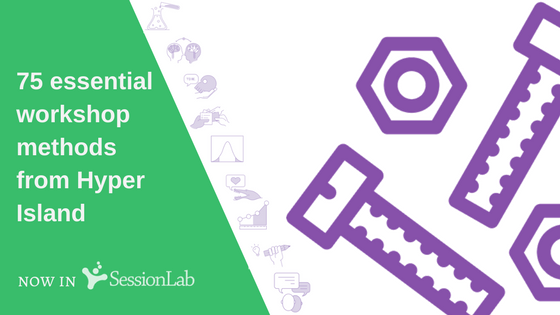75 essential workshop methods from Hyper Island (now in SessionLab library)

Nowadays when we graduate from the university and get our diplomas there is one thing we need to face as soon as possible: our learning journey does not stop when we throw our hats into the sky. To stay relevant in the job market and at our workplaces, we constantly have to learn, explore and master new skills. We need to become lifelong learners. Even though this is nowadays almost self-evident, in 1994 it was still a new and a bit vague concept.
In that same year Lars Lundh, Jonathan Briggs, and David Erixon were sitting in a bar, discussing a project. They came to the realization that night that the digital era was upon us. Therefore not just individuals but organizations needed to change their way of learning and become lifelong learners to stay ahead of their game. They had a vision in mind: to build an institution where professional and personal learning would be equally important, learning design would be based on flexibility and the ability to deal with change. Soon they discovered a place – a former military prison – that seemed the perfect fit for the school they envisioned. Hyper Island was born.
After almost 25 years a lot has changed in our world, trends have come and gone but the mission that was created by the co-founders stayed the same: to design immersive learning experiences for students and industry professionals, with the aim of developing participants into lifelong learners.
To support learners along their way they introduced Hyper Island Toolbox which contains 75 exercises and activities that can be applied in the workplace by anyone who wants to enhance collaboration, creativity and learning-by-doing in teams on a daily basis. This approach would enable teams to grow, individuals to build competence, to boost confidence and seize their potential, ultimately making organizations more adept in a world of constant change.
Methodically the Toolbox was built on 3 main guidelines. The first one is learning-by-doing. This widely used learning approach has four steps: a concrete experience, reflection on that experience, drawing conclusions and applying these conclusions. Exploring Client Centricity follows the same four steps while participants need to focus on being more client-centric.
Exploring Client Centricity #hyperisland #innovation #explore and understand
Client-centricity” (or “client-focus”) is an approach to business based on putting the client/customer at the center of an organization’s philosophy, strategy, and operations. This exercise promotes collaborative exploration and reflection around an organization’s approach to its clients. Participants discuss and share positive experiences they have had as clients, and use this to define their approach to “client-centricity” as a group. They discuss different groups of clients based on needs, and explore how successfully the organization has met those needs in the past. The exercise ends with a prioritization of areas for improvement.
The second guideline is reflection. The practice of reflection enables individuals and organizations to learn more and develop quicker. For instance, History Map can be used as a collective reflection exercise at the end of a team project.
History Map #hyperisland #team
The main purpose of this activity is to remind and reflect on what group members or participants have been through and to create a collective experience and shared story. Every individual will gain a shared idea of what the group has been through together. Use this exercise at the end of a project or program as a way to reinforce learnings, celebrate highlights and create closure.
Finally, the third one is designing a workshop. The tools in the Toolbox are designed to be used individually or in combinations within workshops. 3 Action Steps can be a good example of that, it can be used on its own or as a part of a workshop to define the steps of an action plan.
3 Action Steps #hyperisland #action
This is a small-scale strategic planning session that helps groups and individuals to take action toward a desired change. It is often used at the end of a workshop or programme. The group discusses and agrees on a vision, then creates some action steps that will lead them towards that vision. The scope of the challenge is also defined, through discussion of the helpful and harmful factors influencing the group.
Are you ready to get familiar with different prototyping or feedback techniques, master your project management and teamwork skills or become the battery of your group by providing great energisers when the energy level is decreasing in your team? With a high-quality yet simple and understandable Hyper Island Toolbox by your side, it is easier than ever! Another good news for you is that now you can find all Hyper Island methods in the SessionLab public library of facilitation methods. Take a look at them and don’t forget to mark your favourites along the way!
If you want to know more about Hyper Island, the courses they offer, their activities or the community and team behind them, visit www.hyperisland.com for further information.
What is your favourite Hyper Island method? Let us know in the comments!



Leave a Comment